Low Fat Sausage Market Research, 2031
The global low fat sausage market size was valued at $2.5 billion in 2021, and is projected to reach $4.8 billion by 2031, growing at a CAGR of 6.7% from 2022 to 2031.
A low sausage is a type of meat product usually made from ground meat-often beef, pork, or poultry along with salt, spices, and other flavourings where the level of fat is comparatively lower than the normal sausage. Other ingredients, such as grains or breadcrumbs may be included as fillers or extenders. In addition, vegan sausage is also included in low-fat sausage segment.
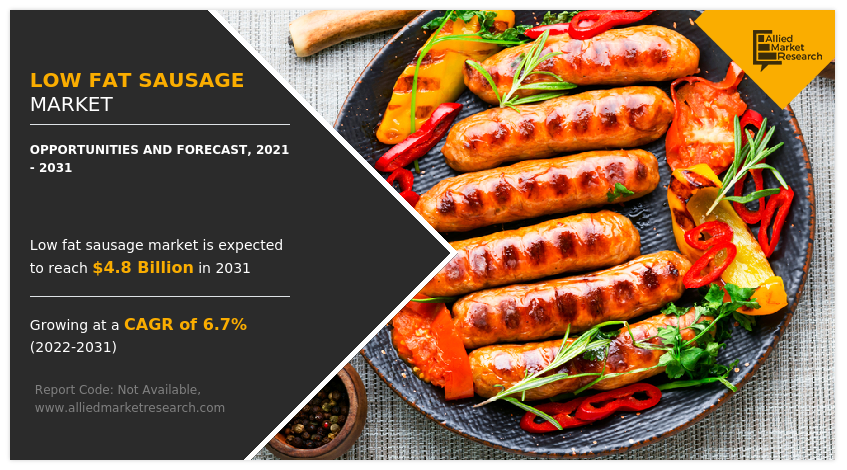
Market Dynamics
In developing nations, the trend of food consumption is drastically altering along with the rise in the standard of living. According to studies, processed food consumption has increased along with rising disposable income since it takes less time to prepare and is therefore more convenient for those leading busy lives. The demand for sausages and other meat products is also being fuelled by the expanding presence of quick-service restaurants, fast casual dining establishments, and cloud kitchens in developing countries. Quick-service restaurants like McDonald's, Burger King, KFC, Taco Bell, and Wendy's are just a few examples. These fast-food chains are growing in emerging nations, which is increasing the demand for processed foods globally. Therefore, with the increase in consumption of fast food and processed food in developing countries, the demand for low-fat sausages is rising.
Furthermore, the clean eating trend is on rise, wherein consumers want to know and understand what they are eating. Globally, consumers are seeking products with clean labels and recognizable ingredients while manufacturers are opting for ingredients that offer high performance and applications, with simple ingredients sourced from low-processed food. Plant-based meat include ingredients, such as fibers, starches, gums, and other stabilizers, in addition to plant-based proteins. They are multi-functional as well as natural. Therefore, increase in demand for clean label and natural products are one of the major factors propelling the growth of the low fat sausage market.
The improvement of logistics, rise in affordability, expansion of international trade, and rise in consumer spending have all contributed to the recent solid growth of the global food and beverage business. Additionally, the food and beverage business has been consistently changing to meet consumer demands. Additionally, because consumers want ready-to-eat and affordable food, the need for packaged and convenient food has multiplied. Additionally, the growth of the food manufacturing sector is anticipated to increase global demand for packaged goods by increasing the popularity of fast food. As a result, the expansion of the global low fat sausage market is driven by all these variables taken together.
However, sausages can be a very unhealthy food choice. When processing meat, preservatives like nitrites and nitrates, which naturally present in red meat, are frequently added. Stomach cancer can result from these substances because the body can transform them into chemicals that cause cancer. Furthermore, sausages contain a high salt and fat content that has been associated with elevated blood pressure. Diabetes and hypertension frequently coexist. Consuming too much salt causes hypertension to spiral out of control, which can have an impact on a person's blood sugar levels. Additionally, smoking meat can produce carcinogens, which have been proven to be hazardous to human health. As a result, a wide range of health problems related to sausages are impeding the market expansion of low-fat sausages.
Since two to three decades ago, customers have been drawn to the availability of meat and meat products such deli meat, processed meat, cold cut meat, and meat by-products. Meat products are evolving over time in response to consumer needs and market demand. Consumers today demand meat products from producers to be of the highest quality. Manufacturing businesses are putting flavoured meat products on the market in response to consumer demand in an effort to draw customers. To bring out the greatest flavours in their meat mixtures, businesses use savoury herbs and spices. After eating, customers notice the distinctive flavour. Sales of sausages are anticipated to rise as a result of the market's introduction of flavoured and processed meat. The inclination of consumers toward flavoured and processed meat products is anticipated to offer lucrative opportunities for market players to introduce new flavour variants in their low-fat sausages.
In addition, increase in penetration of internet and rise in percentage of population inclining toward online shopping are expected to provide potential opportunity for the low-fat sausage manufacturers to sell their existing as well as novel low-fat sausage products through online platform, thus making them easily available for consumers and increasing consumer awareness about their products.
The low fat sausage market in Asia-Pacific offers lucrative growth opportunities for the operating players. This is attributed to increase in adoption of western lifestyle and rise in disposable income of consumers. Moreover, this region offers potential growth opportunities to the market players for launching innovative meat substitute products. Moreover, countries in Latin America, such as Brazil, would unfold attractive business opportunities, owing to high prevalence of obesity in this region.
Segment Overview
The global low fat sausage market is segmented into type, end user, distribution channel, and region. On the basis of type, the market is categorized into pork, beef, chicken, plant-based, and others. On the basis of end user, the market is categorized into residential and commercial. On the basis of distribution channel, it is fragmented into supermarket/hypermarket, specialty stores, convenience store, online sales channel, and others. Region wise, low fat sausage market share is analyzed across North America (U.S., Canada, and Mexico), Europe (UK, Germany, France, Italy, Spain, Russia, and rest of Europe), Asia-Pacific (China, India, Japan, Australia & New Zealand, South Korea, ASEAN, and rest of Asia-Pacific), and LAMEA (Brazil, Saudi Arabia, Turkey, South Africa, and rest of LAMEA).
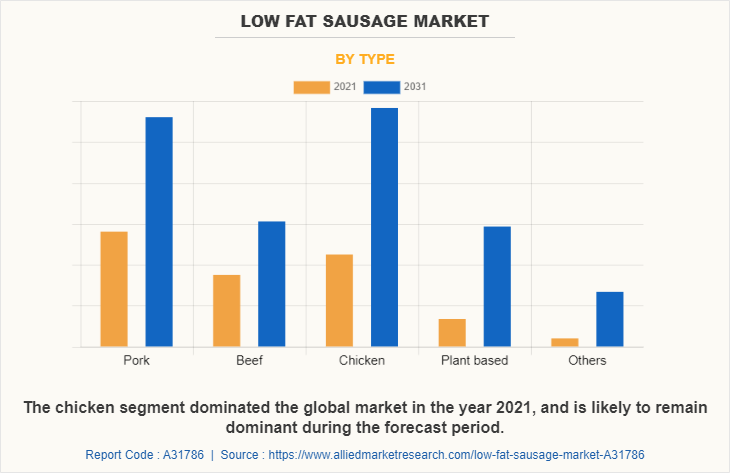
On the basis of type, pork segment had the dominating low fat sausage market share in the year 2021, and is likely to remain dominant during the forecast period. This is attributed to growing pork production which has quadrupled in the last 50 years, and is expected to rise further over the next three decades. According to Porkcheckoff.org, a government website, global pork consumption in 2020 is expected to be around 212 billion pounds. Pork products are popular among consumers, as they contain less saturated fat, cholesterol, and sodium. Moreover, pork is lower in calories, and protein quality is better than beef due to the presence of a high quantity of amino acids. Rise in consumption of pork in the market has encouraged the farm owners to expand the pork production to cater to the low fat sausage market demand.
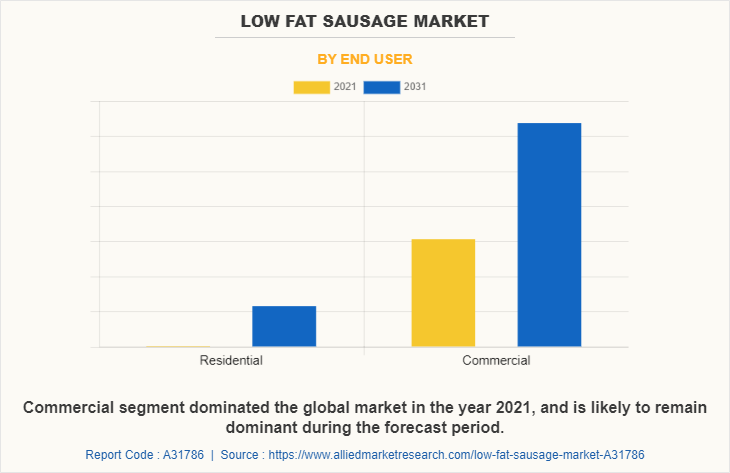
On the basis of end user, commercial segment dominated the low fat sausage industryin the year 2021, and is likely to remain dominant during the forecast period. This is attributed to the growing demand for commercial areas like restaurant, café, as a place for consumer to sit and socialize and in order to spend time with new and different food consumption has changed the pattern of food consumption owing to the growth of working class comprising of the millennial populations. Furthermore, the rise in the number of food dishes available and growing adoption of different and newer food menus pooled with the introduction of home delivery services has significantly increased the growth of the food service industry. Therefore, boosting the low fat sausage market growth in the process.
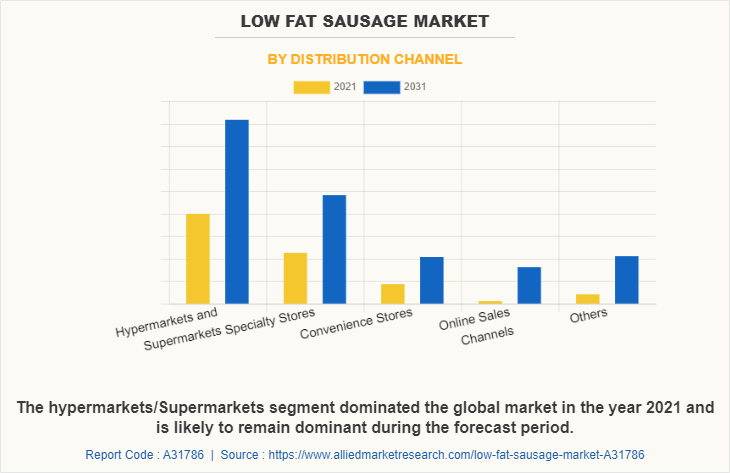
On the basis of distribution channel, hypermarkets/supermarkets dominated the global market in the year 2021, and is likely to remain dominant during the low fat sausage market forecast period. For all the needs of consumers, hypermarkets are considered to be a one-stop shop and provide all the things that an individual may need every day. The low fat sausage have good opportunity to grow with the help of hypermarkets & supermarkets distribution channel. The reason for this is easy availability of the products. Consumers could have access to niche products on the market in these types of stores. Thus, the establishment of hypermarkets/supermarkets at a widespread location gives way to lucrative opportunities for the growth of the global low fat sausage market.
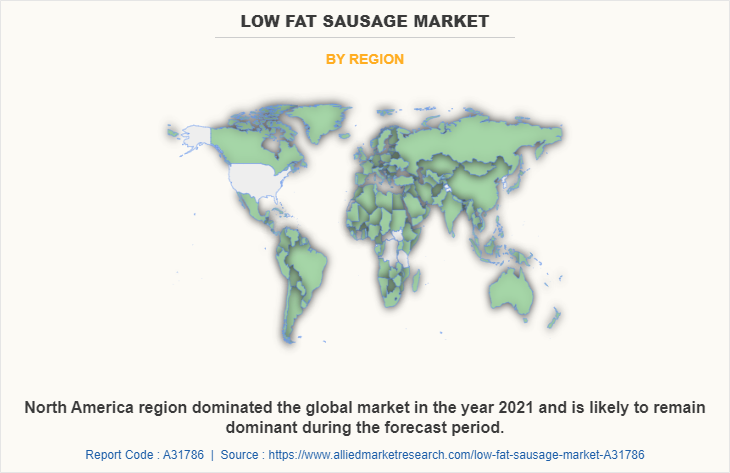
Region-wise, low fat sausage market size is analyzed across North America (the U.S., Canada, and Mexico), Europe (UK, Germany, France, Italy, Spain, Russia and rest of Europe), Asia-Pacific (China, India, Japan, Australia & New Zealand, South Korea, ASEAN and rest of Asia-Pacific), and LAMEA (Brazil, Argentina, UAE, South Africa, and rest of LAMEA). North America dominated the global market in the year 2021 and is likely to remain dominant during the forecast period. In addition, North America region dominated the global market in the year 2021, and is likely to remain dominant during the forecast period. North America processed meat market is anticipated to grow due to surge in working population, increase in disposable income, and higher demand for ready-to-cook and ready-to-eat food products. According to the United Nations, Food and Agriculture Organization, the U.S. is one of the leading meat producers and meat consumers just after China. However, the U.S. ranks first in the consumption of processed meat due to the larger prevalence of hotels, fast food chains, and cafes. For this, the U.S. is anticipated to maintain its dominance during the forecast period.
Competitive Analysis
According to the low fat sausage market players, the major obstacle attributed to the pandemic was disruption of the supply chain. Furthermore, all the distribution channels were nearly shut down in the first quarter of the pandemic. However, online channels such as Amazon and Flipkart were delivering the products. The key players analyzed in the low fat sausage market report are Atria Plc., Beyond Meat, Heck Food Ltd, Hormel Foods Corp., JBS S.A., Johnsonville LLC, Nestlé S.A., Premium Brands Holding Corporation, Tyson, and WH Group Limited.
Key Benefits For Stakeholders
- This report provides a quantitative analysis of the market segments, current trends, estimations, and dynamics of the low fat sausage market analysis from 2021 to 2031 to identify the prevailing low fat sausage market opportunities.
- The market research is offered along with information related to key drivers, restraints, and opportunities.
- Porter's five forces analysis highlights the potency of buyers and suppliers to enable stakeholders make profit-oriented business decisions and strengthen their supplier-buyer network.
- In-depth analysis of the low fat sausage market segmentation assists to determine the prevailing market opportunities.
- Major countries in each region are mapped according to their revenue contribution to the global market.
- Market player positioning facilitates benchmarking and provides a clear understanding of the present position of the market players.
- The report includes the analysis of the regional as well as global low fat sausage market trends, key players, market segments, application areas, and market growth strategies.
Low Fat Sausage Market Report Highlights
| Aspects | Details |
| Market Size By 2031 | USD 4.8 billion |
| Growth Rate | CAGR of 6.7% |
| Forecast period | 2021 - 2031 |
| Report Pages | 331 |
| By Type |
|
| By End User |
|
| By Distribution Channel |
|
| By Region |
|
| Key Market Players | JBS S.A., Premium Brands Holding Corporation, Hormel Foods corp., Johnsonville LLC., WH Group Limited, Atria Plc., Heck Food Ltd , Tyson, Beyond Meat, Nestlé S.A. |
Analyst Review
In the view of CXO, the incidence of obesity-related disorders, such as diabetes, cardiovascular diseases, and others, has considerably increased in the last few years. According to the Organization for Economic Co-operation and Development (OECD), obesity levels are expected to be particularly high in the U.S., Mexico, and England, where 47%, 39%, and 35% of the population, respectively, are projected to be obese in 2030. Individuals in high-income geographical regions, such as North America and Western Europe, are more prone to diabetes, cancer, and other critical health issues, owing to their unhealthy food and lifestyle habits. Increase in incidence of such health disorders boosts health and fitness consciousness among consumers. The adoption of vegetarian foods is on a consistent increase across the world. According to recent studies, 30% of Americans are not only leaving meat off their plates but also seeking out plant-based meat alternatives. Consumers are projected to become selective in their food habits to avoid severe health issues. Therefore, the demand for low fat sausage is likely to rise in the near future.
CXO further stated that, the market in Asia-Pacific offers lucrative growth opportunities for the operating players. Increase in adoption of western lifestyle and rise in disposable income of consumers majorly drive the growth of the market. This region offers potential growth opportunities to the market players for launching innovative meat substitute products or low fat meat products. Moreover, countries in Latin America, such as Brazil, would unfold attractive business opportunities, owing to high prevalence of obesity in this region.
Changing Lifestyles and Urbanization in Developing Nations, Health and Wellness Trends, Expansion of the Food & Beverage Industry, Flavored and Premium Product Offerings, E-commerce Growth, Regional Opportunities majorly contribute toward the growth of the market.
North America dominated and is projected to maintain its leading position throughout the forecast period.
The key players profiled in the reports includes Hormel Foods corp., Atria Plc., Heck Food Ltd , WH Group Limited, Johnsonville LLC., Beyond Meat, Tyson, Nestlé S.A., Premium Brands Holding Corporation, JBS S.A.
The global low fat sausage market is projected to grow at a compound annual growth rate of 6.7% from 2022-2031 to reach USD 4.8 billion by 2031.
The global low fat sausage market size was valued at USD 2.5 billion in 2021, and is projected to reach USD 4.8 billion by 2031.
Loading Table Of Content...



